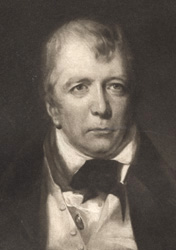|
|
Home | Corson Collection | Biography | Works | Image Collection | Recent Publications | Correspondence | Forthcoming Events | Links | E-texts | Contact Sir John Watson Gordon's 1820 Portrait of Sir Walter ScottThe half-length portrait painted by Sir John Watson Gordon in 1820 presents Scott in full face, holding his terrier Ourisque, and wearing a brown coat over a buff waistcoat.
Scott sat for Watson Gordon at some point between 1 June 1820, when he informed Lady Abercorn that 'the sitting for my picture is not quite begun yet' (Letters, VI, 201), and 1 July when he reported 'the portrait is advancing by the pencil of a clever artist and will I think be a likeness and a tolerably good picture' (VI, 217). Scott asked Lady Abercorn to forgive him 'if I look a little sleepy' as 'I had to make my attendance on the man of colours betwixt six and seven in the morning.' A letter of 2 August 1820 confirms that the portrait is complete and has been consigned to the post. Scott adds: 'The dog which I am represented as holding in my arms is a Highland terrier from Kintail of a breed very sensible very faithful, and very ill-natured. It sometimes tires or pretends to do so when I am on horseback and whines to be taken up when it sits before me like a child without any assistance.' (VI, 252) Lady Abercorn replied on 10 August that she hoped the portrait 'was as like you as your Bust [by Chantrey]'. Even if it did not depict 'one of the most distinguished men of this age', she would value it 'as that of one of the best of friends, one that circumstances has [sic] only changed in showing more kindness and Attachment in Adversity than in prosperity' (VI, 253). The painting was badly damaged when Rougham Hall was bombed in 1940 and subsequently cut down. The signature and the dog no longer exist. It was never engraved but photogravures were taken for The Scott Exhibition MDCCCLXXI (1872) and Caw's Scott Gallery (1903). Bibliography
In addition to the above sources, this page draws on unpublished research by James C. Corson. Last updated: 17-Feb-2009 |
||||


